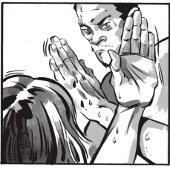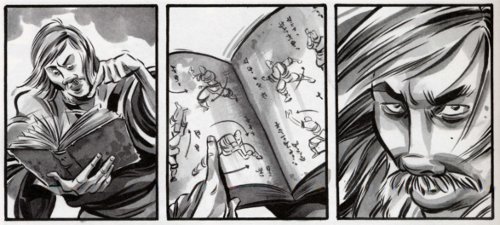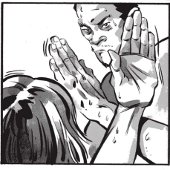 I always have trouble writing about comics that I think are good, just excellent and existing in their own seamless perfection, which means that here at the Gutter I don’t always write about the comics that I love most. I want to do credit to them and save them till I have more time. Sometimes, I struggle just to say something beyond, “It’s good.” I’ve had that problem with Infinite Kung Fu (Top Shelf, 2011). Fortunately, the book’s also gotten me thinking about action in a static medium and decompressed storytelling.
I always have trouble writing about comics that I think are good, just excellent and existing in their own seamless perfection, which means that here at the Gutter I don’t always write about the comics that I love most. I want to do credit to them and save them till I have more time. Sometimes, I struggle just to say something beyond, “It’s good.” I’ve had that problem with Infinite Kung Fu (Top Shelf, 2011). Fortunately, the book’s also gotten me thinking about action in a static medium and decompressed storytelling.
Kagan McLeod’s graphic novel is a tour de force and like most masterpieces it’s been a long time in the making. I got my first issue of Infinite Kung Fu at one of Toronto’s late lamented Kung Fu Fridays screenings. Later, I heard McLeod was reworking it as a graphic novel. I impatiently watched Top Shelf’s new releases and, finally, when the book was due to be released, it wasn’t. McLeod wasn’t finished. But Infinite Kung Fu was worth all the waiting and even at over 450 well-bound, well-written and beautifully-drawn pages, it’s not too long at all. McLeod’s lush linework, influenced by both Chinese calligraphy and Hip Hop tagging, would be worth it alone. But there’s more. The Master Killer himself, Gordon Liu, and film programmer—and Kung Fu Fridays sifu—Colin Geddes introduce the book. McLeod also includes an essay, Brubaker-style,* on the history of Chinese martial arts cinema from the silent era to the present.
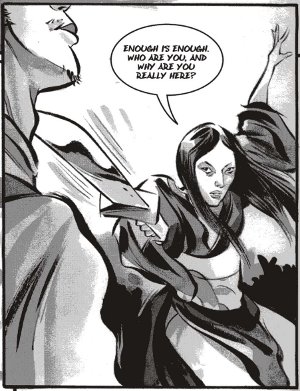 The book’s set in the Martial World. In kung fu and wuxia stories, the Martial World/ Jiang Hu, is parallel to our own, encompassing a subculture of secret societies, itinerant heroes, martial arts masters and their disciples. In Infinite Kung Fu, the Martial World is beset by the risen dead. Yang Kei-Lung is a soldier serving in one of the Emperor of the Martial World’s five armies, but finds his destiny when he encounters the chief of the Eight Immortals, Chung Li-Ch’uan. Chung chooses Yang as his student, tasking Yang with restoring the balance of life and death. There are also evil generals, secret manuals, Shaolin Bronze Men and a kung fu master based on George Clinton (Moog Joogular). And this kung fu comic culminates in an astonishing 84-page end fight.
The book’s set in the Martial World. In kung fu and wuxia stories, the Martial World/ Jiang Hu, is parallel to our own, encompassing a subculture of secret societies, itinerant heroes, martial arts masters and their disciples. In Infinite Kung Fu, the Martial World is beset by the risen dead. Yang Kei-Lung is a soldier serving in one of the Emperor of the Martial World’s five armies, but finds his destiny when he encounters the chief of the Eight Immortals, Chung Li-Ch’uan. Chung chooses Yang as his student, tasking Yang with restoring the balance of life and death. There are also evil generals, secret manuals, Shaolin Bronze Men and a kung fu master based on George Clinton (Moog Joogular). And this kung fu comic culminates in an astonishing 84-page end fight.
I’ve written before about comics as a medium for the crazy mash-up. And Infinite Kung Fu does mix worlds, with Moog Joogular and his Funkadelic city grooving in the Martial World’s midst. I’ve also written about comics as a silent medium and comics as a medium for horror. In struggling with how to write about Infinite Kung Fu, I started thinking about action in a static medium. It’s self-evident, but in comics the movement, the action, the punches—whether Superman’s or Yang’s—are illusory. Yet, the most popular comics are two-fisted and action-packed.
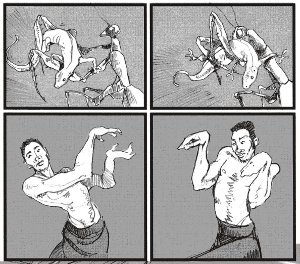 McLeod’s gorgeous brush and line work go a long way in creating a sense of motion, speed and power. McLeod’s panel layout and frames not only order the action, but elegantly emphasize a single blow’s impact or a character’s response. The book also features elements of decompressed storytelling, currently, the most common way of presenting action in comics. It’s also called, “deconstructed storytelling,” but “deconstruction” has particular connotations for me.
McLeod’s gorgeous brush and line work go a long way in creating a sense of motion, speed and power. McLeod’s panel layout and frames not only order the action, but elegantly emphasize a single blow’s impact or a character’s response. The book also features elements of decompressed storytelling, currently, the most common way of presenting action in comics. It’s also called, “deconstructed storytelling,” but “deconstruction” has particular connotations for me.
In decompressed storytelling, action is organized cinematically. It’s an attempt to create the experience of watching the story onscreen. A compressed story is usually complete within the space of 20-some pages. A decompressed narrative is usually complete within 4-6 comics—the number of issues collected in a trade paperback. A decompressed comic’s space allows readers to admire the art. But when action is laid out as if it were a movie, the attempt to immerse me frame by frame distracts me because it makes a comic come across as a quick sketch of a film.
Infinite Kung Fu‘s final fight breaks action down into individual moves, but it doesn’t seem cinematic in quite the above sense. And that’s a little strange, because the book is all about a love of classic martial arts cinema. Maybe it’s that McLeod uses decompression appropriately. After all, Shaw Brothers are right there behind Infinite Kung Fu. And McLeod highlights stances and styles in a way reminiscent of pre-1980s martial arts films, combatants announcing styles or pausing between sets of movements to allow enthusiasts to recognize, say, Mantis Fist. But the action reminds me of something else, too—the diagrams demonstrating stances in kung fu manuals.
Because Chinese martial arts are also a textual tradition using teaching manuals, kung fu has always existed in a static medium. Martial arts stories themselves are rife with secret books and prodigies with eidetic memories learning an entire style in a single glance. In fact, there is a long line of people with very bad or even no kung fu who discover secret books or carvings in a hidden chamber that allow them to become superhumanly powerful. In Infinite Kung Fu, Immortal Chung leaves Yang at the bottom of a cliff with piles of books. Yang can only stack them to climb back up again once he has finished them all. Yang’s rival steals books of poison style kung fu and a secret Shaolin style and becomes inconceivably dangerous—and mad—from studying them.
In the end, portraying action in a static medium has advantages—and not just for mastering secret kung fu styles. In Infinite Kung Fu, it’s easier to believe in the devastating power of the Emperor’s Greater Yin Fist or a head hopping across a battlefield and onto its neck, because those depictions exist on the same plane, in the same style as everything else in that world. Unlike in a moving medium, they can’t be undermined by bad special effects. Further, the creator controls what the reader does and does not see. The action in a comic depends on the creator’s skill in rendering and on both the creator’s and reader’s imagination.
Between art and imagination, kung fu can indeed be infinite.
*Ed Brubaker and Sean Philips include essays with their comics, Criminal, Incognito and Fatale. It’s a nice trend that’s showing up in other creator-owned books like Near Death and The Rinse.
~~~
Carol Borden regrets that she didn’t buy one of Kagan McLeod’s Bride With White Hair or Lo Lieh t-shirts when she had the chance.
Full disclosure: Carol received this book as a review copy. Kagan McLeod designed the poster for this year’s ActionFest, the only film festival dedicated to movies that go BOOM! Kagan McLeod also designed the trailer for ActionFest, and Carol wrote text for it. Carol is writing for the ActionFest blog again this year. ActionFest’s director Colin Geddes also wrote a blurb for the Cultural Gutter’s book. But Carol’s heart is untainted for they were all brought together by the love of kung fu and she would’ve written more about Infinite Kung Fu regardless.
Categories: Comics

